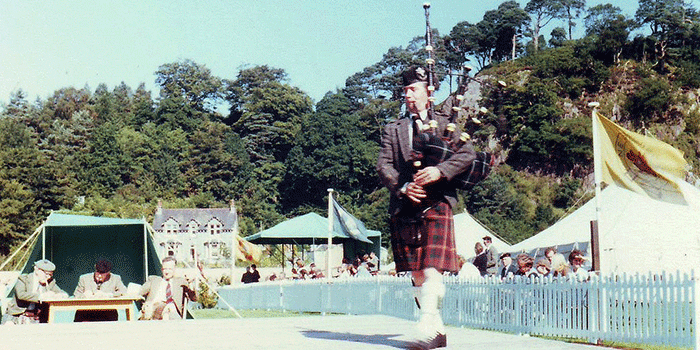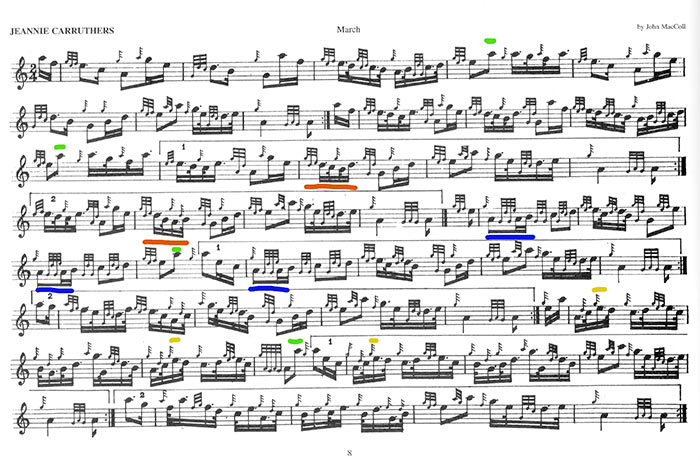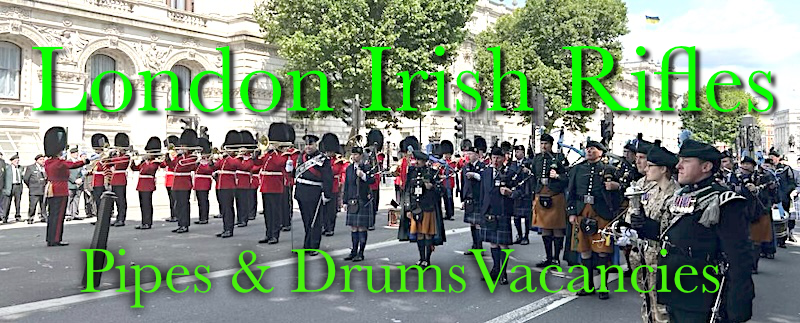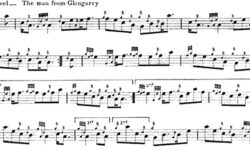
Following last week’s features on Iain Morrison, we are very grateful to Patrick Molard in Brittany for forwarding this recording from the 1971 Argyllshire Gathering, writes the Editor.
It is of Iain Murdo playing in the Former Winners’ March Strathspey and Reel. Whilst it is not Iain at his best (he seems nervous and there a few slips) it is indicative of his style of playing and the brilliance with which he executed it.
The tunes are Jeannie Carruthers, Susan MacLeod and Caber Feidh played twice through:
More….
As regards the setting of Jeannie Carruthers, Iain plays the second time differently than the standard setting as per Seumas MacNeill’s book (one change is marked below with the brown line). I don’t know where the other changes Iain has in this part come from but they are certainly attractive:

John Burgess told me once that at the start of the third part MacColl originally wrote a long low A (dotted quaver or eighth note) instead of the taorluath and certainly that’s what John played when I heard him in recital. It’s marked on the music in blue.
Very few bands attempt this tune. One of the first was Bob Hardie’s Muirheads who won a World Chanmpionship with it. Hardie added a high A doubling at the places marked green. He also added a doubling on E at the places marked in yellow. This adds to the difficulty of this march masterpiece but I think improves it. There were other minor changes where he put E gracenotes in instead of high G.
‘I idolised Iain’s playing and to this day I regard him as one of the most beautiful light music players I have ever heard….’
…… Bill Livingstone from his memoir ‘Preposterous Tales to Follow’
Back to Iain’s performance. Yes, I believe he was a little nervous in his delivery and the odd slip would not have helped. But what is significant is that here we have a recording from half a century ago which displays a difference in approach to the safety first style of today.
This is a piper playing on the edge for one of the two most prestigious light music prizes on the planet. Not for him a cautious plod. No, he was going for it; it was first or burst.
On this occasion it didn’t work out, but as all who heard him can attest, this was the exception rather than the rule. When it clicked, as it usually did, it was magical and it is because of this that fifty years on we still remember the music of P/M Iain Morrison.


















Hi Robert, the second part of Jeannie Carruthers as played here by Iain Morrison appears on p28 of The Glenallan Collection, I don’t know the date of publication of that collection but as all prices are in shillings and pence it’s of some age, the rest of the tune he plays differently however, particularly the fourth part.
As a former pupil of John Burgess I confirm he omitted the Taorluath at the start of the third part, he’s surely correct that this was the original intention of John MacColl as John would have had this from Willie Ross, a contemporary of John MacColl. We might also look to the comments of Archibald Campbell, Kilberry who wrote to the Piping Times in its early years stating Marches pre G S MacLennan were much less embellished. For my part I prefer it without the Taorluath, a period of a single held note is attractive and distinctive.
Hi Robert, the second part of Jeannie Carruthers as played here by Iain Morrison appears on p28 of The Glenallan Collection, I don’t know the date of publication of that collection but as all prices are in shillings and pence it’s of some age, the rest of the tune he plays differently however, particularly the fourth part.
The following comment is interesting in that a John MacColl student, Alexander Ross Boyd brought it with him to Nova Scotia in the 1940 s:
“John Burgess told me once that at the start of the third part MacColl originally wrote a long low A (dotted quaver or eighth note) instead of the taorluath and certainly that’s what John played when I heard him in recital. It’s marked on the music in blue.”
Although this small stylistic approach did not carry on in the piping, Sandy Boyd’s influence on Cape Breton Fiddlers’ renditions of this march still carries on today.